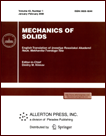 | | Mechanics of Solids
A Journal of Russian Academy of Sciences | | Founded
in January 1966
Issued 6 times a year
Print ISSN 0025-6544
Online ISSN 1934-7936 |
Archive of Issues
| Total articles in the database: | | 13362 |
| In Russian (Èçâ. ÐÀÍ. ÌÒÒ): | | 8178
|
| In English (Mech. Solids): | | 5184 |
|
| << Previous article | Volume 59, Issue 6 / 2024 | Next article >> |
| Z. Wang, Y. Zhang, Q. Shen, and E.Q. Liu, "Anisotropic Mechanical Behaviors and Constitutive Model of AZ31 Magnesium Alloy Sheets," Mech. Solids. 59 (6), 3559-3570 (2024) |
| Year |
2024 |
Volume |
59 |
Number |
6 |
Pages |
3559-3570 |
| DOI |
10.1134/S0025654424605391 |
| Title |
Anisotropic Mechanical Behaviors and Constitutive Model of AZ31 Magnesium Alloy Sheets |
| Author(s) |
Z. Wang (School of Applied Science, Taiyuan University of Science and Technology, Taiyuan, Shanxi, 030024 China, 2021046@tyust.edu.cn)
Y. Zhang (School of Applied Science, Taiyuan University of Science and Technology, Taiyuan, Shanxi, 030024 China)
Q. Shen (School of Applied Science, Taiyuan University of Science and Technology, Taiyuan, Shanxi, 030024 China)
E.Q. Liu (School of Applied Science, Taiyuan University of Science and Technology, Taiyuan, Shanxi, 030024 China) |
| Abstract |
Compared with traditional metal materials, the advantages of magnesium alloys are high
specific strength and high specific stiffness, which are widely used in various fields of industrial production. The rolling magnesium alloy material has relatively complex mechanical properties due to its
crystal structure and texture from processing. Uniaxial quasi-static tensile tests with five orientations
along the rolling direction were designed based on the macroscopic elastic-plasticity theory to investigate the mechanical properties of AZ31 magnesium alloy sheets. Experimental true stress-strain and
the plastic strain ratio were obtained by the DIC strain-measurement method, the initial yield strength
decreases as the angle increases from 0 to 90°, while the tensile strength, in contrast, increases overall
as the angle increases. The anisotropic yield criterion and plastic potential function were established
in the basic form of the Hill48 yield function. The composite linear-swift hardening model was constructed according to the hardening characteristics of the material. Besides, the complete constitutive
model was obtained by calibrating the parameters in the function with the experimental results. The
anisotropic model was further validated based on the commercial finite element software COMOSL.
The experimental results were compared to confirm the validity of the anisotropic model of AZ31 magnesium alloy sheets. |
| Keywords |
rolling magnesium alloy, anisotropic yield criterion, anisotropic plastic potential function, hardening model, Finite element method |
| Received |
16 September 2024 | Revised |
18 November 2024 | Accepted |
18 November 2024 |
| Link to Fulltext |
|
| << Previous article | Volume 59, Issue 6 / 2024 | Next article >> |
|
 If you find a misprint on a webpage, please help us correct it promptly - just highlight and press Ctrl+Enter If you find a misprint on a webpage, please help us correct it promptly - just highlight and press Ctrl+Enter
|
|

 Russian
Russian  English
English